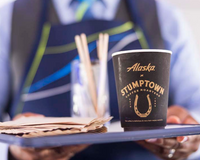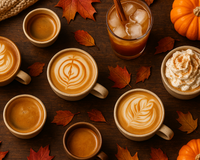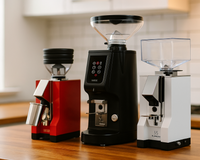Whether you're a coffee connoisseur or someone who simply relies on that caffeine kick to get through the day, understanding the caffeine content in your favorite espresso drink is important. In this comprehensive guide, we will delve into the specifics of caffeine levels in double-shot espressos, helping you make informed choices about your daily caffeine intake.
From uncovering the science behind caffeine extraction to exploring the variables that can affect caffeine content, we will leave no stone unturned. Join us on this caffeine-filled journey as we unravel the secrets of doubleshot espresso and help you take your coffee experience to a whole new level.
So, grab your favorite mug and get ready to dive into the world of caffeine content in doubleshot espresso. It's time to demystify and understand what's really in your beloved energizing drink.
What is caffeine and its effects on the body?

Caffeine is a naturally occurring stimulant compound found in various plants, including coffee beans, tea leaves, cocoa beans, and kola nuts. It is one of the most widely consumed psychoactive substances in the world, and for good reason. Caffeine works by blocking the action of adenosine, a neurotransmitter in the brain that normally promotes feelings of drowsiness and fatigue. By blocking adenosine, caffeine increases the activity of other neurotransmitters, such as dopamine and norepinephrine, which can lead to improved mood, enhanced cognitive function, and increased energy levels.
The effects of caffeine on the body can be both beneficial and potentially harmful, depending on the amount consumed and the individual's sensitivity. In moderate doses, caffeine can improve alertness, concentration, and physical performance. It can also boost metabolism and aid in weight loss by increasing thermogenesis, the process of heat production in the body. However, excessive caffeine consumption can lead to side effects such as anxiety, insomnia, jitteriness, rapid heartbeat, and even addiction in some individuals.
CHECK THIS OUT: HERE'S HOW MUCH CAFFEINE IS IN MCDONALDS ICDED COFFEE
It's important to understand the recommended caffeine intake guidelines, which vary depending on age, health status, and individual sensitivity. The FDA recommends a maximum daily caffeine intake of 400 milligrams (mg) for healthy adults, while the American Academy of Pediatrics advises limiting caffeine intake for children and adolescents. By being mindful of your caffeine consumption, you can harness the benefits of this stimulant while avoiding the potential drawbacks.
Understanding caffeine content in espresso

Espresso is a concentrated form of coffee, made by forcing hot water under pressure through finely-ground coffee beans. This extraction process results in a small, intense shot of coffee with a rich, full-bodied flavor. The caffeine content in espresso is typically higher than in other coffee preparations, such as drip coffee or French press, due to the concentrated nature of the drink.
The caffeine content in a single shot of espresso can range from around 60 to 100 milligrams, depending on various factors. A double-shot espresso, or "doubleshot," contains approximately twice the amount of coffee grounds and, consequently, roughly double the caffeine content of a single shot, typically ranging from 120 to 200 milligrams.
YOU MIGHT LIKE: HERE'S HOW MUCH CAFFEINE IS IN A STARBUCKS FRAPPUCCINO
It's important to note that the caffeine content in espresso can vary significantly based on factors such as the type of coffee beans used, the roast level, the grind size, the water temperature, and the extraction time. Specialty coffee roasters and baristas may fine-tune these variables to optimize the flavor and caffeine content of their espresso drinks, resulting in a wide range of caffeine levels even within the same café or coffee shop.
Factors that affect caffeine content in Doubleshot Espresso
The caffeine content in a doubleshot espresso can be influenced by a variety of factors, including the coffee beans, the roasting process, the grind size, and the brewing method. Understanding these variables can help you make informed choices about your caffeine intake and customize your espresso experience to suit your preferences.
Coffee Beans: The type of coffee beans used can have a significant impact on the caffeine content of a doubleshot espresso. Generally, Arabica beans tend to have a lower caffeine content compared to Robusta beans, which are known for their higher caffeine levels. The origin, processing method, and varietal of the coffee beans can also affect the final caffeine content.
Roast Level: The roasting process can also influence the caffeine content in espresso. Lighter roasts typically retain more of the original caffeine content of the coffee beans, while darker roasts may result in a slightly lower caffeine concentration due to the breakdown of some caffeine molecules during the roasting process.
Grind Size: The grind size of the coffee beans can impact the extraction efficiency and, consequently, the caffeine content in the final espresso shot. A finer grind can increase the surface area of the coffee grounds, leading to a more efficient extraction and potentially higher caffeine levels. Conversely, a coarser grind may result in a less complete extraction and a lower caffeine content.
How to measure caffeine content in Doubleshot Espresso
Measuring the exact caffeine content in a doubleshot espresso can be a challenging task, as there are several variables involved. However, there are a few methods and tools that can help you get a more accurate estimate of the caffeine levels in your favorite espresso drink.
Laboratory Analysis: The most precise way to determine the caffeine content in a doubleshot espresso is to have it analyzed in a laboratory setting. This involves using specialized equipment, such as high-performance liquid chromatography (HPLC) or gas chromatography-mass spectrometry (GC-MS), to accurately measure the caffeine concentration in the sample. While this method provides the most reliable results, it can be time-consuming and costly, making it impractical for most coffee enthusiasts.
ALSO READ: UNDERSTANDING CAFFEINE IN ESPRESSO: THE ULTIMATE GUIDE
Caffeine Content Databases: There are several online databases and resources that provide estimated caffeine content for various coffee and espresso drinks. These databases, such as the USDA Food Composition Database or the caffeine informational website CaffeineInformer.com, can give you a general idea of the caffeine levels in a doubleshot espresso based on industry averages and research. However, keep in mind that these values are approximations and may not reflect the exact caffeine content of your specific drink.
Caffeine Testing Kits: For a more hands-on approach, you can use caffeine testing kits designed for home or personal use. These kits typically involve a simple color-changing reaction or a digital readout that can provide an estimate of the caffeine content in your doubleshot espresso. While not as accurate as laboratory analysis, these kits can give you a better understanding of the caffeine levels in your drink.
Comparing caffeine content in Doubleshot Espresso with other espresso drinks

When it comes to caffeine content, a doubleshot espresso is not the only espresso-based drink you may encounter. It's important to understand how the caffeine levels in a doubleshot espresso compare to other popular espresso drinks, as this can help you make informed choices about your caffeine intake.
Single-Shot Espresso: A single-shot espresso typically contains around 60 to 100 milligrams of caffeine, making it the baseline for espresso-based drinks. Compared to a doubleshot, a single-shot espresso has approximately half the caffeine content.
Americano: An Americano is made by diluting a single-shot of espresso with hot water, resulting in a drink that is similar in appearance and flavor to drip coffee. The caffeine content in an Americano is generally lower than a doubleshot espresso, ranging from around 80 to 150 milligrams, depending on the ratio of espresso to water.
Cappuccino and Latte: These milk-based espresso drinks typically contain a single shot of espresso, with the addition of steamed and frothed milk. The caffeine content in a cappuccino or latte is similar to that of a single-shot espresso, typically ranging from 60 to 100 milligrams.
YOU MIGHT LIKE: MONSTER ENERGY DRINK VS. COFFEE CAFFEINE COUNT
Health considerations and caffeine consumption
While caffeine can provide a range of benefits, such as improved alertness, cognitive function, and physical performance, it's important to be mindful of the potential health implications associated with excessive caffeine consumption. Understanding the recommended guidelines and the potential risks can help you make informed decisions about your caffeine intake, particularly when it comes to doubleshot espresso.
Recommended Caffeine Intake: The FDA recommends a maximum daily caffeine intake of 400 milligrams for healthy adults. This equates to approximately four cups of coffee or two to four doubleshot espressos, depending on the specific caffeine content of the drinks. It's important to note that the recommended intake may vary for certain individuals, such as children, adolescents, pregnant women, and those with underlying health conditions.
Potential Health Risks: Consuming too much caffeine can lead to a range of side effects, including anxiety, insomnia, headaches, jitteriness, and even heart palpitations. Excessive caffeine intake has also been linked to increased blood pressure, disruptions in sleep patterns, and potential negative impacts on bone health and fertility. In some cases, individuals may develop a caffeine addiction, leading to withdrawal symptoms when consumption is reduced or stopped.
Caffeine Sensitivity: It's important to recognize that individual caffeine sensitivity can vary significantly. Factors such as age, genetics, and underlying health conditions can all influence how the body responds to caffeine. Some people may be more sensitive to the effects of caffeine, requiring a lower daily intake to avoid adverse reactions.
Managing caffeine intake for different individuals
Caffeine consumption and its effects can vary greatly from person to person, making it essential to understand your individual needs and preferences when it comes to doubleshot espresso and other caffeinated beverages. By tailoring your caffeine intake to your specific circumstances, you can maximize the benefits while minimizing the potential risks.
Children and Adolescents: The American Academy of Pediatrics recommends that children and adolescents limit their caffeine intake, as their developing bodies may be more susceptible to the negative effects of caffeine. For this age group, it's generally advisable to avoid doubleshot espressos and opt for lower-caffeine alternatives, such as decaffeinated drinks or non-caffeinated beverages.
YOU MIGHT LIKE: HERE'S HOW MUCH CAFFEINE IS IN DUNKIN ICED COFFEE
Pregnant and Breastfeeding Women: Pregnant and breastfeeding women should exercise caution when it comes to caffeine consumption, as high levels of caffeine have been associated with an increased risk of miscarriage, low birth weight, and other potential complications. The recommended maximum daily caffeine intake for this group is typically around 200 milligrams, which may equate to one doubleshot espresso or less.
Individuals with Underlying Health Conditions: People with certain medical conditions, such as heart disease, anxiety disorders, or sleep disturbances, may need to be more mindful of their caffeine intake. In these cases, it's essential to consult with a healthcare professional to determine the appropriate level of caffeine consumption and to ensure that it does not exacerbate any existing health concerns.
How to choose the right Doubleshot Espresso for your caffeine needs
With the wide range of caffeine content in doubleshot espressos, it's crucial to find the right balance that meets your personal caffeine needs and preferences. By considering factors such as your individual sensitivity, daily caffeine intake, and specific health requirements, you can make informed choices and enjoy your doubleshot espresso without compromising your well-being.
Understand Your Caffeine Sensitivity: Begin by assessing your personal sensitivity to caffeine. If you find that you are particularly sensitive to the effects of caffeine, you may want to opt for a doubleshot espresso with a lower caffeine content or consider alternative coffee drinks that are less concentrated. Conversely, if you have a higher caffeine tolerance, you may be able to enjoy a doubleshot espresso without experiencing any adverse side effects.
Monitor Your Daily Caffeine Intake: Keep track of your total daily caffeine intake from all sources, including doubleshot espressos, other coffee drinks, energy drinks, and even some medications. This will help you ensure that you stay within the recommended guidelines and avoid exceeding your personal caffeine threshold.
Experiment with Different Roasts and Blends: The caffeine content in doubleshot espressos can vary depending on the type of coffee beans used and the roast level. Consider exploring different roasts and blends to find the one that provides the perfect balance of flavor and caffeine content for your preferences.
Conclusion and final thoughts
In conclusion, understanding the caffeine content in doubleshot espresso is crucial for coffee lovers who want to make informed choices about their daily caffeine intake. By delving into the science behind caffeine extraction, exploring the various factors that influence caffeine levels, and comparing doubleshot espresso to other espresso-based drinks, we have provided you with a comprehensive guide to unveiling the mystery of caffeine content in this beloved beverage.
Whether you're a seasoned coffee connoisseur or someone just starting to explore the world of espresso, this guide has equipped you with the knowledge and tools to make informed decisions about your caffeine consumption. By understanding your individual sensitivity, monitoring your daily intake, and experimenting with different roasts and blends, you can find the perfect doubleshot espresso that satisfies your taste buds and your caffeine needs.
Remember, moderation is key when it comes to caffeine consumption. While doubleshot espresso can provide a delightful and energizing experience, it's essential to be mindful of the potential health implications associated with excessive caffeine intake. By striking the right balance, you can enjoy the benefits of caffeine while prioritizing your overall well-being.
So, the next time you indulge in a doubleshot espresso, take a moment to appreciate the complex and fascinating world of caffeine content. Savor the rich, bold flavor, and feel empowered by your newfound understanding of this energizing elixir. Happy sipping!















